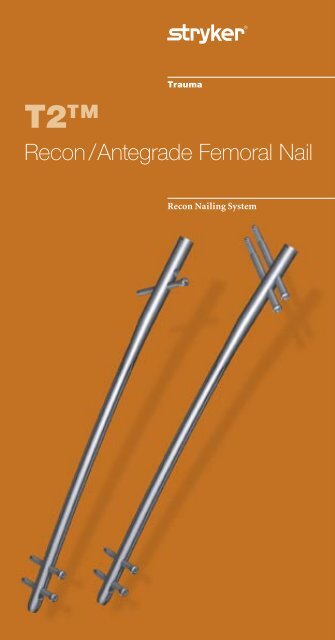Recon / Antegrade Femoral Nail - Stryker
Recon / Antegrade Femoral Nail - Stryker
Recon / Antegrade Femoral Nail - Stryker
Create successful ePaper yourself
Turn your PDF publications into a flip-book with our unique Google optimized e-Paper software.
Trauma<br />
T2<br />
<strong>Recon</strong> / <strong>Antegrade</strong> <strong>Femoral</strong> <strong>Nail</strong><br />
<strong>Recon</strong> <strong>Nail</strong>ing System
T2<br />
<strong>Recon</strong> / <strong>Antegrade</strong> <strong>Femoral</strong> <strong>Nail</strong><br />
To complement the T2 <strong>Nail</strong>ing System, <strong>Stryker</strong><br />
Trauma has created a “new generation” femoral<br />
implant:<br />
The T2 <strong>Recon</strong> <strong>Nail</strong> offers surgeons two<br />
options – cannulated and solid lag screw insertion<br />
technique – while using a common T2 instrument<br />
platform.<br />
Unique design features for the <strong>Recon</strong> T2 <strong>Nail</strong> include:<br />
• Flexibility to switch from a standard antegrade<br />
femoral application to a recon application<br />
without changing the nail. This is achieved<br />
through a smart nail design that incorporates<br />
two locking configurations.
0mm<br />
0mm<br />
26mm<br />
70°<br />
125° CCD<br />
44mm<br />
10.5mm<br />
4° lateral valgus bend<br />
• Easy Trochanteric Tip Insertion due to a 4°<br />
valgus bend plus an antecurvature of approximately<br />
2000mm.<br />
• 5mm Fully Threaded Screw that targets the<br />
Lesser Trochanter due to a proximal oblique<br />
70° locking hole with 7° retroversion.<br />
• Insertion of two cannulated 6.5mm Lag<br />
Screws at a 125° CCD angle with a 10° lag<br />
screw anteversion. Secure Placement in Small<br />
<strong>Femoral</strong> Necks is achieved with a 10.5mm<br />
distance between the Lag Screws (17mm outer<br />
screw distance).<br />
• Cannulated 6.5mm Lag Screws for optimal<br />
insertion via a K-Wire. The Lag Screw has a<br />
special thread design for better grip, improved<br />
front cutting flutes for lower insertion torque<br />
and thinner flanks for less bone removal*.<br />
• Static or Dynamic distal locking options.<br />
• All T2 implants are made of type II anodized<br />
titanium alloy (Ti6Al4V) for enhanced biomechanical<br />
and biomedical performance.<br />
* test reports (310303CG4/5) on file at <strong>Stryker</strong>
The information presented in this brochure is intended to demonstrate a <strong>Stryker</strong> product. Always<br />
refer to the package insert, product label and/or user instructions before using any <strong>Stryker</strong> product.<br />
Surgeons must always rely on their own clinical judgment when deciding which products and<br />
techniques to use with their patients. Products may not be available in all markets. Product availability<br />
is subject to the regulatory or medical practices that govern individual markets. Please contact your<br />
<strong>Stryker</strong> representative if you have questions about the availability of <strong>Stryker</strong> products in your area.<br />
Products referenced with designation are trademarks of <strong>Stryker</strong>.<br />
Products referenced with ® designation are registered trademarks of <strong>Stryker</strong>.<br />
Literature Number: B1000025<br />
LOT C2505<br />
Copyright © 2005 <strong>Stryker</strong><br />
Printed in Germany<br />
<strong>Stryker</strong> Trauma GmbH<br />
Prof.-Küntscher-Strasse 1-5<br />
D-24232 Schönkirchen - Germany<br />
www.trauma.stryker.com

















